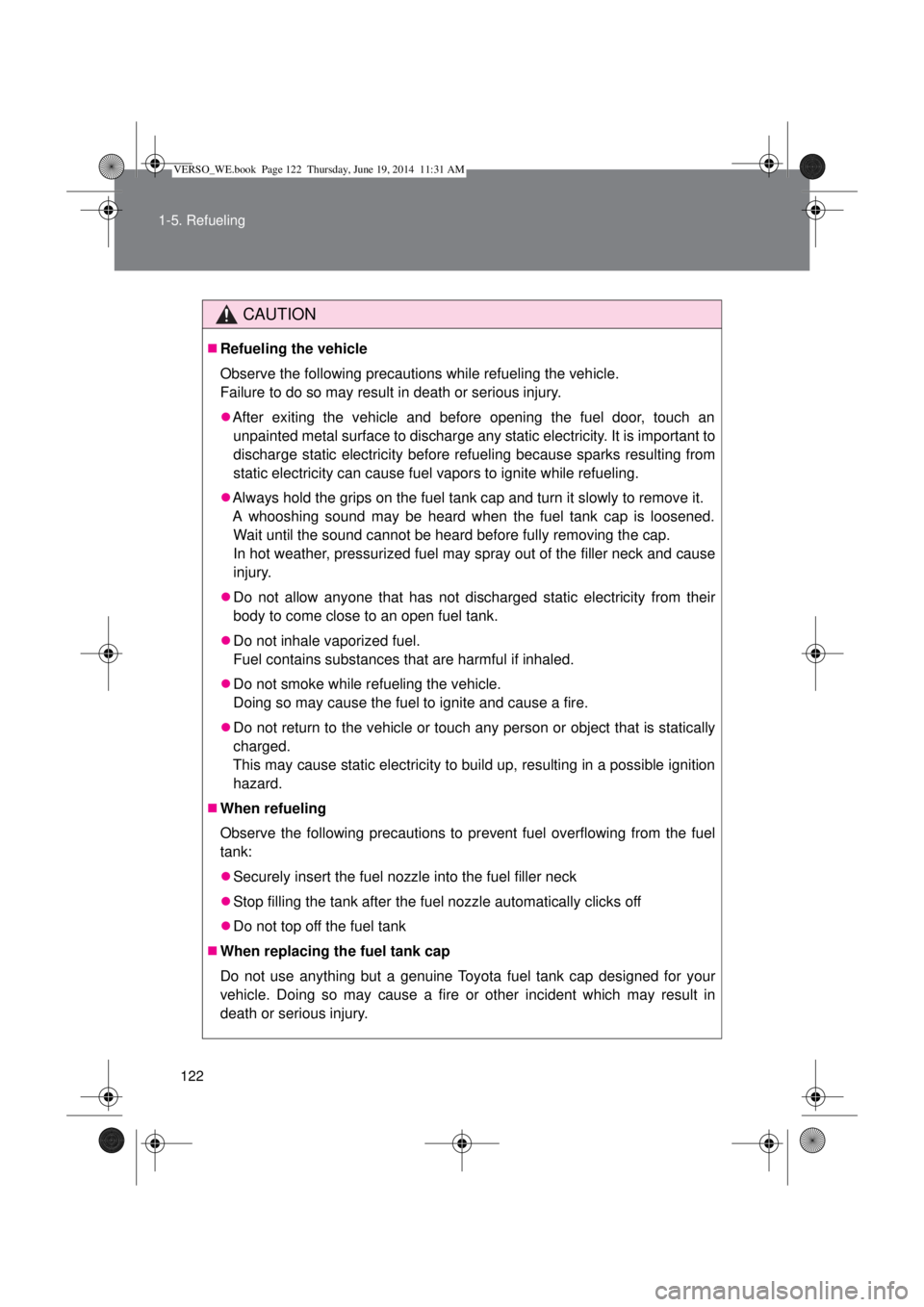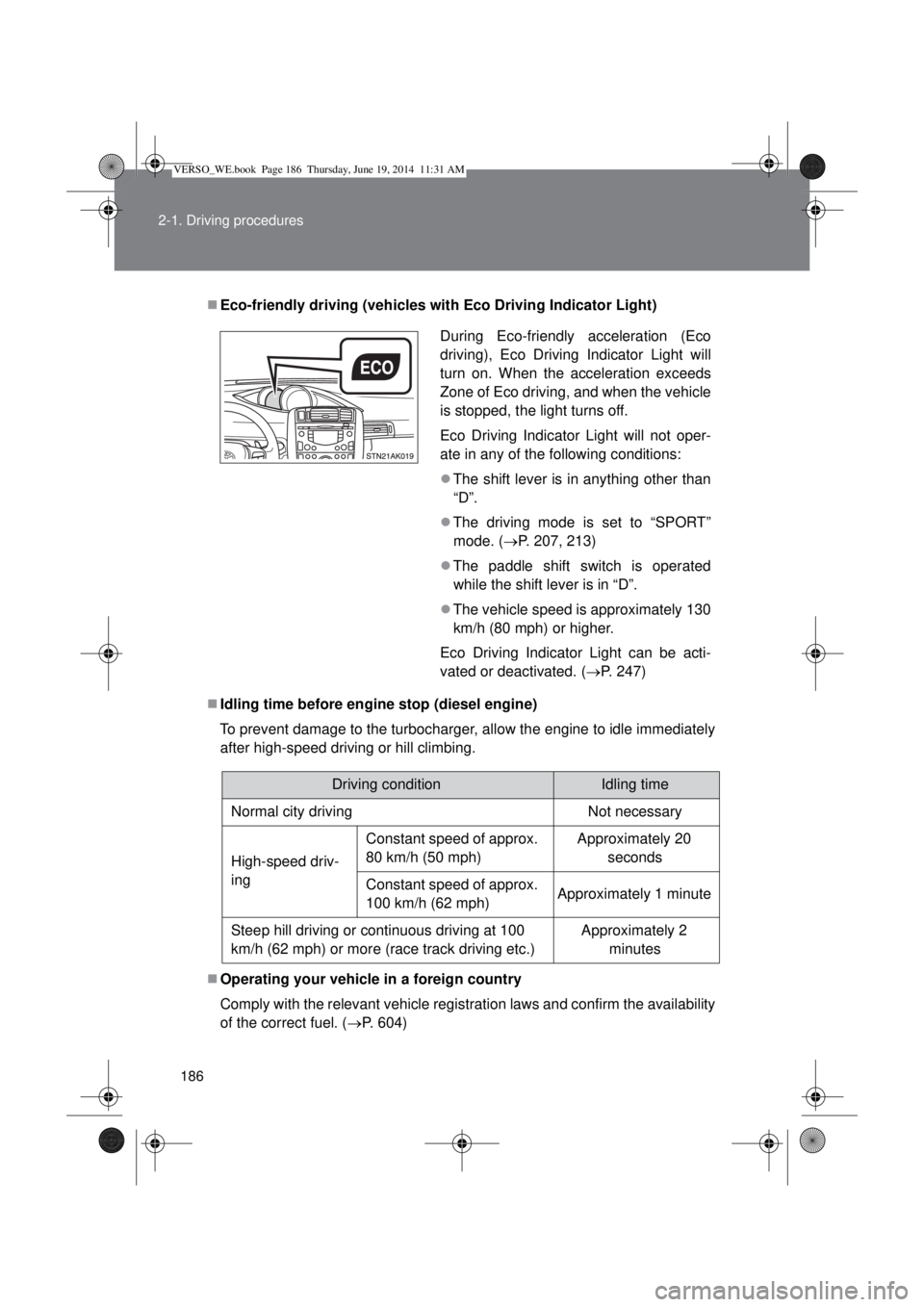Page 118 of 650
118
1-5. Refueling
Opening the fuel tank cap
Perform the following steps to open the fuel tank cap.
Before refueling the vehicle
Vehicles without smart entry & start system
Turn the engine switch off and ensure that all the doors and
windows are closed.
Confirm the type of fuel. (P. 120)
Vehicles with smart entry & start system
Turn the “ENGINE START STOP” switch off and ensure
that all the doors and windows are closed.
Confirm the type of fuel. (P. 120)
Opening the fuel tank cap
Pull up the fuel filler door
opener.
VERSO_WE.book Page 118 Thursday, June 19, 2014 11:31 AM
Page 119 of 650
119 1-5. Refueling
1
Before driving
Turn the fuel tank cap slowly
to open it.
Hang the fuel tank cap on the
back of the fuel filler door.
VERSO_WE.book Page 119 Thursday, June 19, 2014 11:31 AM
Page 120 of 650
120 1-5. Refueling
Closing the fuel tank cap
When installing the fuel tank cap,
turn it until you hear a click.
The cap will turn slightly to the
opposite direction when released.
Fuel types
Gasoline engine
EU area:
Unleaded gasoline conforming to European standard EN228, Research
Octane Number of 95 or higher
Except EU area:
Unleaded gasoline, Research Octane Number of 95 or higher
Diesel engine
Fuel type can be identified by the fuel label.
“DIESEL”
Diesel fuel that contains 500 ppm or
less of sulphur, and a cetane number
of 48 or higher
“LOW SULPHUR DIESEL”
Diesel fuel that contains 50 ppm or
less of sulphur, and a cetane number
of 48 or higher
VERSO_WE.book Page 120 Thursday, June 19, 2014 11:31 AM
Page 121 of 650

121 1-5. Refueling
1
Before driving
*1: To distinguish the 1AD-FTV engine, ask any authorized Toyota dealer or
repairer, or another duly qualified and equipped professional.
*2: Fuel type can be identified by the fuel label. (P. 120)
Use of ethanol blended gasoline in a gasoline engine
Toyota allows the use of ethanol blended gasoline where the ethanol content
is up to 10%. Make sure that the ethanol blended gasoline to be used has a
Research Octane Number that follows the above.
Engine/Model codeType
1AD-FTV (without DPF
catalytic converter)
*1 engineFuel label
*2
“DIESEL”
Diesel fuel that contains 500 ppm or
less of sulphur and has a cetane
number of 48 or higher
“LOW SULPHUR DIESEL”
Diesel fuel that contains 50 ppm or
less of sulphur and has a cetane
number of 48 or higher
1AD-FTV (with DPF catalytic
converter)
*1, 2AD-FHV and
1WW-FHV enginesEU area:
Diesel fuel conforming to European
standard EN590
Except EU area:
Diesel fuel that contains 50 ppm or less
of sulphur and has a cetane number of
48 or higher
VERSO_WE.book Page 121 Thursday, June 19, 2014 11:31 AM
Page 122 of 650

122 1-5. Refueling
CAUTION
Refueling the vehicle
Observe the following precautions while refueling the vehicle.
Failure to do so may result in death or serious injury.
After exiting the vehicle and before opening the fuel door, touch an
unpainted metal surface to discharge any static electricity. It is important to
discharge static electricity before refueling because sparks resulting from
static electricity can cause fuel vapors to ignite while refueling.
Always hold the grips on the fuel tank cap and turn it slowly to remove it.
A whooshing sound may be heard when the fuel tank cap is loosened.
Wait until the sound cannot be heard before fully removing the cap.
In hot weather, pressurized fuel may spray out of the filler neck and cause
injury.
Do not allow anyone that has not discharged static electricity from their
body to come close to an open fuel tank.
Do not inhale vaporized fuel.
Fuel contains substances that are harmful if inhaled.
Do not smoke while refueling the vehicle.
Doing so may cause the fuel to ignite and cause a fire.
Do not return to the vehicle or touch any person or object that is statically
charged.
This may cause static electricity to build up, resulting in a possible ignition
hazard.
When refueling
Observe the following precautions to prevent fuel overflowing from the fuel
tank:
Securely insert the fuel nozzle into the fuel filler neck
Stop filling the tank after the fuel nozzle automatically clicks off
Do not top off the fuel tank
When replacing the fuel tank cap
Do not use anything but a genuine Toyota fuel tank cap designed for your
vehicle. Doing so may cause a fire or other incident which may result in
death or serious injury.
VERSO_WE.book Page 122 Thursday, June 19, 2014 11:31 AM
Page 123 of 650
123 1-5. Refueling
1
Before driving
NOTICE
Refueling
Do not spill fuel during refueling.
Doing so may damage the vehicle, such as causing the emission control
system to operate abnormally or damaging fuel system components or the
vehicle’s painted surface.
VERSO_WE.book Page 123 Thursday, June 19, 2014 11:31 AM
Page 186 of 650

186 2-1. Driving procedures
Eco-friendly driving (vehicles with Eco Driving Indicator Light)
Idling time before engine stop (diesel engine)
To prevent damage to the turbocharger, allow the engine to idle immediately
after high-speed driving or hill climbing.
Operating your vehicle in a foreign country
Comply with the relevant vehicle registration laws and confirm the availability
of the correct fuel. (P. 604)During Eco-friendly acceleration (Eco
driving), Eco Driving Indicator Light will
turn on. When the acceleration exceeds
Zone of Eco driving, and when the vehicle
is stopped, the light turns off.
Eco Driving Indicator Light will not oper-
ate in any of the following conditions:
The shift lever is in anything other than
“D”.
The driving mode is set to “SPORT”
mode. (P. 207, 213)
The paddle shift switch is operated
while the shift lever is in “D”.
The vehicle speed is approximately 130
km/h (80 mph) or higher.
Eco Driving Indicator Light can be acti-
vated or deactivated. (P. 247)
Driving conditionIdling time
Normal city driving Not necessary
High-speed driv-
ingConstant speed of approx.
80 km/h (50 mph)Approximately 20
seconds
Constant speed of approx.
100 km/h (62 mph)Approximately 1 minute
Steep hill driving or continuous driving at 100
km/h (62 mph) or more (race track driving etc.)Approximately 2
minutes
VERSO_WE.book Page 186 Thursday, June 19, 2014 11:31 AM
Page 207 of 650
207 2-1. Driving procedures
2
When driving
Selecting a shift position
*1: To improve fuel consumption and reduce noises, set the shift lever in
the “D” position for normal driving.
*2: If equipped, by selecting gear step using paddle shift switches, you can
control engine braking forces.
Selecting a driving mode
Press the switch.
For powerful acceleration and
driving in mountainous
regions.
Press the switch once more to
return the normal mode.
Shift positionFunction
PParking the vehicle or starting the engine
RReversing
NNeutral
DNormal driving*1 or temporary gear step selection
driving
*2
M7-speed sport sequential shiftmatic mode driving
(P. 209)
VERSO_WE.book Page 207 Thursday, June 19, 2014 11:31 AM